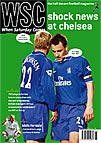 Now the whole of the ground has gone, but for Tim Springett a piece of Southampton history vanished as long ago as 1981, when “progress” put paid to a very odd looking stand indeed
Now the whole of the ground has gone, but for Tim Springett a piece of Southampton history vanished as long ago as 1981, when “progress” put paid to a very odd looking stand indeed
A Saturday afternoon in March was approaching the time of twilight when, having spent most of the match defending stoutly, Southampton’s opponents Bolton broke forward from the far end. The ball came to Hugh Curran on the edge of the penalty area, who took a shot. What happened from here on in I couldn’t tell you, since from my vantage (ha!) point I couldn’t see the goal at the near end. The next thing I did see though was Curran being mobbed by jubilant team-mates and the home players disconsolately placing the ball on the centre spot to kick off again. What on earth had happened in the meantime? As it was 1975 there was no instant replay screen or even a scoreboard in the ground to help me out, so I was left to my own powers of deduction. My opinion was that Bolton had scored. The following morning the classified results printed in the Sunday Express confirmed that I was, indeed, correct.
The inability to see the goal at the Milton Road end of The Dell was, for many unfortunate fans, one feature of the three elevated enclosures affectionately dubbed the “chocolate boxes” that we tolerated with commendable stoicism. These were three areas of uncovered standing room holding about 300 spectators each, which once towered (sic) above the terracing at the southern end of the ground. Another feature was that, being uncovered and thereby open to the elements, you had to hope it didn’t rain. Some hope in an English winter, even on the south coast. One particularly soggy evening when Saints played Manchester City in the League Cup they didn’t even let the fans in until half an hour before the game because the pitch hadn’t been passed fit before then. So everyone got soaked once while queuing outside and again in the choccie boxes. Fortunately on this occasion I was up in the West Stand and stayed as dry as a bone…
Having said all that, if you got into the ground early enough to stand at the front of any of the boxes, your perspective on the game was breathtakingly good. This was particularly the case in the corner box, from which it was possible to enjoy perhaps the best view of the action available at any football ground on the planet. The corner flag was almost directly below.
Until 1977 the stairs to the middle box had a sign on them stating “Boys only”. The intention was to exclude adults rather than girls and as such it served its purpose of splitting up families rather well. But then about 40 per cent of the end was given over to a new Family Centre, which swallowed up two of the chocolate boxes. Trouble was, they transplanted the “Boys only” sign to the one remaining box, thereby continuing this unfortunate tradition. (For a long time everyone assumed Watford were the first club to designate a Family Centre – in fact, the Saints’ one pre-dated the one at Vicarage Road by at least a year.)
The small print at the turnstiles indicated that the definition of “boys” was ages 0-14. However, if, when asked your age by a steward, you replied you were 14, you were promptly informed you were, in fact, an adult and dispatched to the back of a queue leading to a full-price turnstile. It rather gave the impression that football clubs were only interested in money. Would never happen now, of course.
The boxes were demolished in 1981 partly because of safety concerns – the stairs were steep and narrow (rather like those in the East Stand at Chelsea, but nowhere near as high) – but the main reason was economics. By now Kevin Keegan was a Saint and every game an all-ticket sell-out. The entire Milton Road end was rebuilt, with a new box in the south-west corner for the increasingly popular Family Centre. The new, solitary upper terrace structure was less a chocolate box than one of those huge tins of Quality Street.
The chocolate boxes probably didn’t represent the most economically efficient construction ever at a football ground. They had created space for fewer than 1,000 extra fans and would have reduced the capacity on the terraces below as they were held up by thick concrete pillars that would have meant a severely restricted view for latecomers stuck at the back. But if you talk to any Saints fan who ever stood there to watch a match then he or she will be eternally grateful that they once existed.
From WSC 198 August 2003. What was happening this month